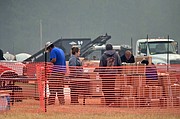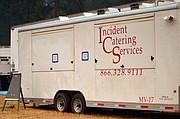Type II team continues to fight area fires
As the fires continue, the smoke is thickening within the county; not just from the active fires within, but also from fires burning in Washington and Oregon.
As recently reported by the CFVP, a Type II Management team is set up within the county, taking control of the Highway 200 Complex fires. The team, along with the on-duty firefighters, are set up on the Naegeli Ranch 10 miles west of Thompson Falls along Highway 200.
U.S. Forest Service Public Information Officer Hailey Graf explained that the camp not only works as a base for both worker and machinery but is also open to the public to stop in and inquire about any of the active fires.
An information tent is set up as you enter the tent site. There, personnel have the current maps on display at the front before you come into the tent where the staff is available to speak.
“We understand that people within the community want to help the firefighters by donating cooked goods. We want to let them know though we appreciate the thought; but we are all set for food and have plenty to go around from our on-site cooks,” said Graf.
As she spoke, she pointed over to a large area where dry goods such as pallets of water were getting held. Graf then walked over toward the mess tent where Incident Catering Services (ICS) is set up.
Graf went further to explain that the cooks on site feed approximately 6,000 calories per person, per meal, per day.
“I know it sounds like a lot, but these guys need that amount with all the exertion they use when on the fires,” said Graf.
Set up in the mess tent was not only the buffet tables that serve salad and desserts but also a food truck that boasted coffee/tea and other drinks.
“The coffee is good. Each day they grind coffee beans on site, so the crew gets a really good cup,” she said.
“In between the shifts, if anyone comes back or is working odder hours than normal, there are things like cereal that are left out in case they want something to eat,” she said.
Graf also explained that the stainless steel holder was also used for any made meals as some people may come back after the meal service is closed. It is used to keep a handful of meals hot, should someone be hungry.
Graf then pointed out how the Incident Command Post layout was set up. As there are approximately 350 crew members working on the Highway 200 Complex as of Sept. 7, there is a rotation of teams working on the live fires.
They set up in one area, so they can sleep or rest with minimal noise and disruption. When the next shift comes in for a changeover, the sleep site will be in another area.
As the fire season continues, Graf said many of the firefighters are put back out on rotation after receiving time off. Considering they are all tired and ready for the season to be done, their morale and spirits are just as good as when it all started.
She explained that when the community gets behind the team and sends in cards, posters of thank you’s and well wishes, it really boosts the morale again.
“It’s a great thing for the crews to walk into the mess hall and see the cards and posters set up as they sit down to eat. They’re tired, looking for some food then to sleep, so to read notes and see the appreciation, it really goes a long way,” Graf said.
Due to the little resources available within the state as well as the county, Graf also expressed gratitude to the prison crew that is responsible for maintaining the cleanliness of the camp.
As ground crews continue to work each blaze, the smoke that has been choking the county for the last week is not that of the Highway 200 Complex fires.
The amount of smoke that has been settling in the county from the out-of-state fires has caused the air quality to become hazardous.
Graf said this is both a blessing and a curse when it comes to the current air quality within the county.
“The smoke is causing a type of blanket that helps with the heat of the sun not being able to heat up any accelerants that will fuel the fire. The conditions have allowed ground crews to establish containment lines. The smoke is also allowing the pilots who have been working air attacks time for rest and maintenance on their machines,” she said.
She further explained that though they are without the air strikes, there are many aspects that ground crews use to help establish possible control of the direction it may take; though she expressed that forest fires are unpredictable.
The Type II Management team not only have been coordinating efforts for all active fires within the county but also ensuring that regular community meetings are being held for residents to obtain up-to-date information. During the latest public meetings in both Thompson Falls and Plains, the management team also made available local health officials speak with attendees should they be experiencing difficulties breathing in the current air conditions.
While symptoms such as sore eyes, tears, coughing and sore throat, headaches and a runny nose can be expected as a reaction to the smoke, more sensitive groups can suffer much worse. Should you be concerned, it is best to seek medical assistance so better precautions can be established.
Basic procedures to lessen smoke inhalation when declared hazardous or dangerous concerning air quality is to close your house. Close windows, doors and limit your air conditioner use. Refrain from lighting candles or using gas stove tops as fresh air circulation is insufficient.
The Sheep Gap and the Reader fires are the only ones at this stage that have been able to obtain some sort of containment by ground crews.
Once weather conditions become more favorable, air attacks will re-commence to strategically remove fuel between fire lines with several burnout operations planned.
Up-to-date notifications about the Highway 200 Complex can be viewed on the CFVP Facebook page or the Highway 200 Complex Facebook page.
-At time of print the recent updates from the Highway 200 Complex now having burnt 22,990 acres and crew numbers sitting at 295 personnel. Sheep Gap fire is nearly at 50% contained with Reader Fires 90% contained.
Air attacks the two days prior were back on the list of defenses as the smoke that was lingering was beginning to move with thanks to some wind that moved into the county. This also enabled ground crews to get in and back burn, implement back lines/fire breaks and spot fire those fuels that haven’t burned to continue further re-igniton.
Those in areas of pre-evacuation status should have spoken with the Sanders County Sheriff representative with regards to their personal properties. The U.S. Forest Service have been hitting the Deep Creek fire hard over the past weekend, though the fire is backing downhill towards Graves Creek and are being held on mechanical lines.
Smoke will be visible as areas within the fire on all active burns will continue to burn. The US Forest service are still holding town meetings for infomration pertaining to the active fires. Residents of Sanders County can still go to the ICP camp west of Thompson Falls for information from onsite PIO Officers.











